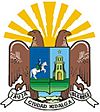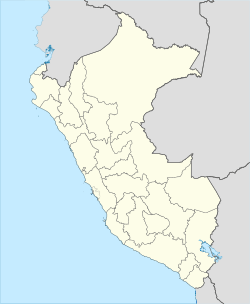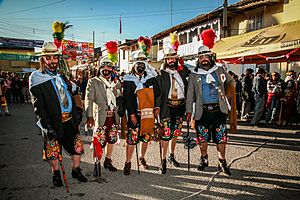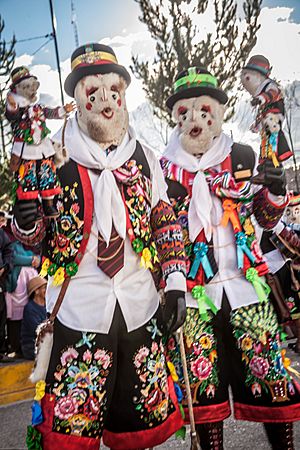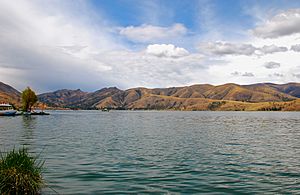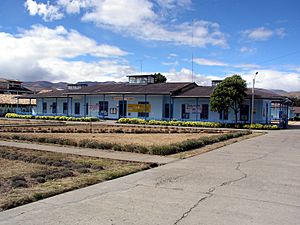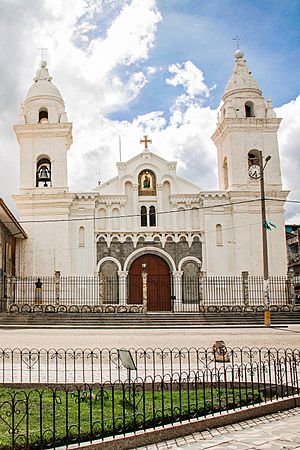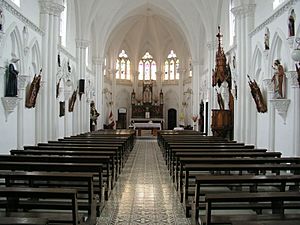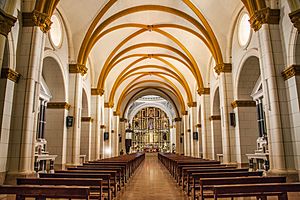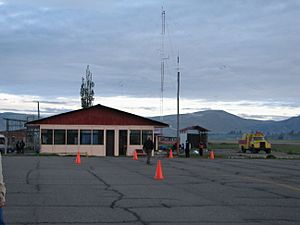Jauja facts for kids
Quick facts for kids
Jauja
|
||
|---|---|---|
|
Town and municipality
|
||
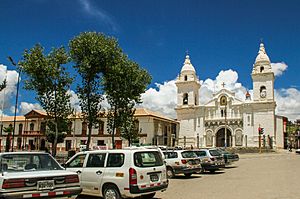
A part of Jauja's main square
|
||
|
||
| Country | ||
| Region | Junín | |
| Province | Jauja | |
| Established | April 25, 1534 | |
| Elevation | 3,400 m (11,200 ft) | |
| Population | ||
| • Estimate
(2015)
|
15,432 | |
| Time zone | UTC-5 (PET) | |
Jauja (also called Shawsha in Wanka Quechua) is a city in Peru. It is the capital of Jauja Province. The city is in the rich Mantaro Valley, about 45 kilometers (28 miles) northwest of Huancayo. Jauja is very high up, at 3,400 meters (11,155 feet) above sea level. In 2015, about 15,432 people lived there.
Jauja was once the first capital of Spanish Peru for a short time. This was before Lima became the new capital city. Its name is used in a famous Spanish saying, país de Jauja. This means "country of Jauja" but really means a "never-never land" or a "land of plenty." The town has a calm feeling and a healthy climate. It has narrow streets with houses painted blue. The beautiful Laguna de Paca lake is also close to the city.
Contents
History of Jauja
Before the Inca Empire, the area was home to the Xauxa people. They lived in a town near where Jauja is today. The Xauxa people later joined the Inca Empire. They were known as brave warriors. Xauxa soldiers helped the Incas expand their empire towards Quito.
Inca Influence and Civil War
The Incas built a main administrative center called "Hatun Xauxa." This city was connected to the rest of the empire by the Qhapaq Ñan, a royal road. This road linked Cusco to Quito. When the Inca Emperor Wayna Qhapaq died, his body was brought through Xauxa. This showed respect for the city and its people. They had been very loyal to him.
During the Inca civil war, the Xauxa people supported the Waskar side. Jauja became a military base for Waskar's army against Atawallpa. The city provided soldiers and supplies. However, Atawallpa's general, Challco Chima, later took over the city. After capturing Cusco, Atawallpa's general Quiz Quiz held Waskar hostage in a fortress in Xauxa.
Spanish Arrival and First Capital
Later, the Spanish leader Francisco Pizarro sent his brother Hernando to collect part of Atawallpa's ransom. Hernando met Challco Chima in the Xauxa Valley. Hernando tricked Challco Chima into coming to Cajamarca, where he was captured. Before Hernando Pizarro arrived, the Xauxa people had rebelled against Atawallpa's army. Challco Chima had punished the rebel leaders.
After the Spanish took over Cusco in 1533, Francisco Pizarro made Xauxa the first capital of Peru. This happened in April 1534. It was named "Santa Fe de Hatun Xauxa." The Spanish found huge amounts of Inca food, clothes, and treasures there. They realized they could live very well for many months.
In 1535, the capital was moved to Lima. This was because Lima was closer to the port of Callao. After this, Jauja became less important. Later, Huancayo grew and became a bigger trade center than Jauja.
Jauja's Health Reputation
Jauja's dry climate was known to be good for people with lung problems. Because of this, many people came to Jauja for health reasons. This brought wealth to the city. It also helped the legend of "the land of Cockaigne" grow stronger. A special hospital, "Domingo Olavegoya," was built in Jauja. Patients came from all over the world, making Jauja a very diverse city. You can still see tombstones with names from many countries in the Jauja cemetery. After new medicines were found, Jauja became less important as a health center. But the small city still has much of its old charm. People from Jauja often call their town "el país de Jauja."
Geography of Jauja
Jauja is in the rich Mantaro Valley. It is about 3,352 meters (10,997 feet) above sea level. The city is on Highway 3S, which goes to Lima. It is 40 kilometers (25 miles) northwest of Huancayo. About 4 kilometers (2.5 miles) north of Jauja is Laguna de Paca. This lake covers an area of 21.4 square kilometers (8.3 square miles). West of the town, near Chocon village, is Laguna Tragadera.
The Mantaro River flows near Jauja. This river forms a large flat area. The Mantaro River valley is in the central highlands of Peru. It is surrounded by tall mountain ranges. This area was formed by different natural forces like glaciers and tectonic activity.
Climate in Jauja
Jauja has a dry climate. This made it a popular place for people with lung conditions to move to. The dry air was thought to be good for their health. Because of its climate and being fairly close to Lima (250 kilometers or 155 miles), many people from Lima often visited Jauja. The weather has three main seasons. The rainy season is from November to April. Winter is from May to July. The dry, sunny season, with strong winds, is from August to October.
| Climate data for Jauja, Sausa, elevation 3,363 m (11,033 ft), (1991–2020) | |||||||||||||
|---|---|---|---|---|---|---|---|---|---|---|---|---|---|
| Month | Jan | Feb | Mar | Apr | May | Jun | Jul | Aug | Sep | Oct | Nov | Dec | Year |
| Mean daily maximum °C (°F) | 18.6 (65.5) |
18.1 (64.6) |
17.9 (64.2) |
19.8 (67.6) |
19.8 (67.6) |
19.5 (67.1) |
19.5 (67.1) |
19.9 (67.8) |
19.9 (67.8) |
19.9 (67.8) |
20.3 (68.5) |
19.2 (66.6) |
19.4 (66.9) |
| Mean daily minimum °C (°F) | 6.6 (43.9) |
6.8 (44.2) |
6.5 (43.7) |
5.1 (41.2) |
2.4 (36.3) |
0.5 (32.9) |
−0.2 (31.6) |
1.2 (34.2) |
3.8 (38.8) |
5.3 (41.5) |
5.7 (42.3) |
6.4 (43.5) |
4.2 (39.5) |
| Average precipitation mm (inches) | 104.8 (4.13) |
109.0 (4.29) |
98.9 (3.89) |
44.6 (1.76) |
14.3 (0.56) |
4.0 (0.16) |
3.5 (0.14) |
4.6 (0.18) |
25.5 (1.00) |
51.5 (2.03) |
65.4 (2.57) |
90.7 (3.57) |
616.8 (24.28) |
| Source: National Meteorology and Hydrology Service of Peru | |||||||||||||
Culture and Traditions
Today, Jauja is a city where people mostly buy and sell farm products. These products come from the Mantaro Valley. The streets are narrow. The houses are built in an old style, often with plaster and big wooden doors.
The town is famous for its markets on Wednesdays and Sundays. Barrio La Libertad is an old neighborhood in the east of the city. Its main square has a monument with a golden eagle. Jauja also has an archaeological museum. It shows items from the ancient Huari culture. There is also a fossil museum, which is a collection by a local person.
Festivals and Celebrations
Jauja has a lively cultural life. Many festivals and events happen throughout the year. The most popular festival is the Feast of San Sebastian and San Fabian on January 20. During this week, the Tunantada dance is celebrated. The Tunantada dance may have started when Peru became a republic. In this dance, local people dress up to imitate the Spanish. They wear masks with funny faces, whiskers, and white skin. Some dancers carry a stick and wear their pants short, like old Spanish noblemen. The music starts with violins. Then, clarinets, harps, and saxophones join in.
Other important festivals include Carnival (February and March). The city also celebrates its Spanish founding day on April 25. Independence Day is in July. Herranza is in August. The Feast of Mamanchic Rosario, Jauja's patron saint, is in October. And the Adoration of the Child is in December.
Churches in Jauja
The Jauja Cathedral (Iglesia Matriz de Jauja) was built in 1564. It has a beautiful Baroque and Rococo style. Inside, you can see carved wooden altars and old retablos. There is also a statue of Our Lady of the Rosary, who is Jauja's patron saint. The church had to be rebuilt after it fell down in 1836. The bell tower is new and has brass bells that can be heard far away.
The Capilla Cristo Pobre church ("Poor Christ Chapel") is another important building. It is built in a Gothic style. It looks a bit like Notre-Dame de Paris. Paintings from France are shown inside. This church is part of the San Vicente de Paul High School.
The Legend of Jauja
In Spanish, Jauja is also the name for the famous La Tierra de Jauja. This means "Land of Cockaigne" or a place where people can live without working. Over time, in songs and stories, the Valley of Jauja became linked to this magical land. However, it was the real wealth found in Jauja when the Spanish arrived that started this myth. Sometimes, the stories show Jauja as an island or a city in a mythical land. Along the Texas-Mexico border, "La ciudad de Jauja" is a funny folk song about this legend.
Jauja is also the setting for a story in "Prisoners of the Sun." This is one of the books in the the Adventures of Tintin comic series by the Belgian artist Hergé.
High Schools
- Colegio Estatal Industrial Integrado Juan Maximo Villar de Jauja (Ex 501)
- Colegio Nacional San Jose de Jauja
- Colegio Nuestra Señora del Carmen de Jauja
- Colegio San Vicente de Paul de Jauja
- Colegio Sagrado Corazon de Jesus
- Colegio Enrique F. Gomez Espinoza
- Colegio Juan Pablo II (private)
- Colegio San Agustín
- Colegio particular Jauja
Transportation
Jauja is connected by highway to Lima and La Oroya. It is the only city in central Peru with an airport, called Francisco Carle Airport. This airport was officially recognized in 1995. Today, it has daily flights. LATAM is the airline that serves Jauja. Most travelers connect through Lima's Jorge Chávez International Airport for other flights.
Notable People
- Hugo Orellana Bonilla
- Daniel Alomía Robles
See also
 In Spanish: Jauja para niños
In Spanish: Jauja para niños


